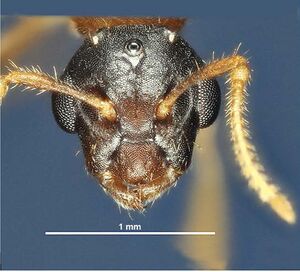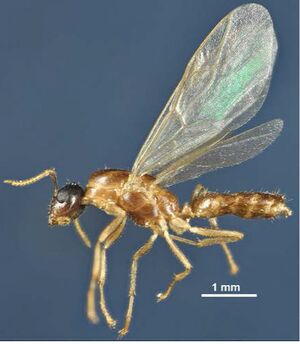Colobopsis rotunda
| Colobopsis rotunda | |
|---|---|

| |
| Scientific classification | |
| Kingdom: | Animalia |
| Phylum: | Arthropoda |
| Class: | Insecta |
| Order: | Hymenoptera |
| Family: | Formicidae |
| Subfamily: | Formicinae |
| Tribe: | Camponotini |
| Genus: | Colobopsis |
| Species: | C. rotunda |
| Binomial name | |
| Colobopsis rotunda (Klimes & McArthur, 2014) | |
The species was found nesting in galleries inside living hollow branches and twigs in the canopies of the host trees at a height of 10 to 17 m. It was tending numerous scale insects (Myzolecanium spp., Coccidae) for honeydew within these nests. This species was quite rare at the studied site as it occurred exclusively in the primary forest plot and occupied only two trees. The host trees belonged to two different species, Dysoxylum brassii MERR. & L. M. PERRY (Meliaceae) and Chisocheton ceramicum (Meliaceae), both of medium size (dbh = 15 cm). A nest was estimated to have at least a thousand workers. However, the workers were not actively foraging in the canopy outside their nests, but moved very slowly within branches. This suggests a cryptic life for the species and a high dependence on honeydew provided by endophytic homopterans. (Klimes & McArthur 2014)
Photo Gallery
Identification
Klimes & McArthur (2014) - Distinguished from other Colobopsis species with phragmosis by being one of the smallest species and by the nearly circular head in front view in minor workers. Colobopsis hosei (minor worker described from Borneo, major unknown), is similar in the shape of mesosoma dorsum and node. However, Colobopsis rotunda can be distinguished from minor workers of this related species by its distinct colouration (much lighter mesosoma and gaster compared with the head), indistinct metanotal groove, presence of erect setae on genae and gula and punctate head.
Distribution
Distribution based on Regional Taxon Lists
Indo-Australian Region: New Guinea.
Distribution based on AntMaps
Distribution based on AntWeb specimens
Check data from AntWeb
Countries Occupied
| Number of countries occupied by this species based on AntWiki Regional Taxon Lists. In general, fewer countries occupied indicates a narrower range, while more countries indicates a more widespread species. |

|
Estimated Abundance
| Relative abundance based on number of AntMaps records per species (this species within the purple bar). Fewer records (to the left) indicates a less abundant/encountered species while more records (to the right) indicates more abundant/encountered species. |

|
Biology
Castes
Queens have yet to be collected.
- Minor Worker
 
| |
| . | |
- Male
 
| |
| . | |
Nomenclature
The following information is derived from Barry Bolton's Online Catalogue of the Ants of the World.
- rotunda. Camponotus rotundus Klimes & McArthur, 2014: 148, figs. 6-8 (s.w.m.) NEW GUINEA (Papua New Guinea).
- Type-material: holotype minor worker, 5 paratype major workers, 7 paratype minor workers, 4 paratype males.
- Type-locality: holotype Papua New Guinea: Madang Prov., Wanang (05°14’S, 145°11’E), 21.iv.2007, HP0084 (P. Klimes); paratypes with same data.
- Type-depositories: SAMA (holotype); IECA, NAIC, NHMW, SAMA (paratypes).
- Combination in Colobopsis: Ward, Blaimer & Fisher, 2016: 350.
- Distribution: Papua New Guinea.
Unless otherwise noted the text for the remainder of this section is reported from the publication that includes the original description.
Description
Worker
Major Structures: in side view, front of head weakly convex from vertex to frontal triangle with a rounded angle of about 135° separating the flattened part of the clypeus and mandibles; finely reticulate. Mesosoma glossy, finely reticulate, pronotum strongly convex, remainder of the mesosoma weakly convex; propodeal angle rounded and about 135°, declivity mostly straight; ratio dorsum / declivity about one. Node thin, front and back mostly straight, summit narrowly rounded. Fore femora about 1.5 times thicker than others. Integument glossy. Head in front view: coarsely punctate, sides straight, diverging to front, vertex mostly flat. Most of clypeus, anterior head and closed mandibles forming a delimited flattish surface. Clypeus with distinct central carina, anterior margin narrow. Frontal carinae distance wide, about 4/5 of head width.
Pilosity: mesosoma with a few erect setae; head with plentiful short erect setae, most of them clavate. Mandibles with short erect setae, some of them clavate. Scape with erect short setae.
Colour: bicoloured; mesosoma and appendages light brown, head distinctly dark brown.
Minor Structures: in side view, front of head smoothly convex with only a change in radius separating the clypeus; mesosoma evenly convex, metanotum indistinct, propodeal angle well rounded, declivity straight, ratio dorsum / declivity about one. Node thin, front and back mostly straight, summit narrowly rounded, wide in rear view. Fore femora about 1.5 times thicker than others. Integument glossy. Head in front view: finely and widely punctate, sides convex, weakly tapering to the front, vertex convex; most of clypeus and closed mandibles forming a circular flat surface, but truncated to a much less extent than in major workers. Anterior margin of clypeus wide, projecting a little and mostly straight, with weak central carina. Frontal carinae distance smaller than in majors, approaching two thirds of head width.
Pilosity: in side view, plentiful short erect setae wide-spread on mesosoma, head, scapes, tibiae, less on gaster, plentiful raised short setae on gula. Mandibles with short erect setae.
Colour: similar to major workers.
Male
CI = 88, EL = 0.38, FCD = 0.41, HL = 0.96, HW = 0.84, ML = 1.77, PW = 0.88, SI = 75, SL = 0.63.
Structures: in side view, mesosoma elongate with dorsum mostly flat, node triangular. In front view, head sides straight and strongly tapering to the front. Vertex strongly convex, slightly flattened in centre. Eye length of nearly half head length. Frontal carinae separated by more than a third head width, front femora not enlarged.
Pilosity: short erect setae on scape.
Colour: light brown body with yellow legs, except for the head dark brown as in workers.
Type Material
Holotype (minor worker, South Australian Museum): “Papua New Guinea: Madang Province, Wanang (05° 14' S, 145° 11' E), 21.IV.2007, HP0084, leg. P. Klimes”. Paratypes: From the same nest series, labelled as above: 4 minor workers, 2 major workers, 3 males (South Australian Museum); 1 minor worker and 1 major worker (Naturhistorisches Museum Wien, Vienna, National Agricultural Insect Collection); 1 male, 2 minor workers and 2 major workers (Czech Academy of Sciences).
Etymology
Named for the nearly circular shape of the head in minor workers.
References
- Klimes, P. & McArthur, A.J. 2014. Diversity and ecology of arboricolous ant communities of Camponotus (Hymenoptera: Formicidae) in a New Guinea rainforest with descriptions of four new species. Myrmecological News 20, 141-158.
- Klimeš, P., Drescher, J., Buchori, D., Hidayat, P., Nazarreta, R., Potocký, P., Rimandai, M., Scheu, S., Matos-Maraví, P. 2022. Uncovering cryptic diversity in the enigmatic ant genus Overbeckia and insights into the phylogeny of Camponotini (Hymenoptera:Formicidae:Formicinae). Invertebrate Systematics, 36(6), 557-579 (doi:10.1071/is21067).
- Ward, P.S., Blaimer, B.B., Fisher, B.L. 2016. A revised phylogenetic classification of the ant subfamily Formicinae (Hymenoptera: Formicidae), with resurrection of the genera Colobopsis and Dinomyrmex. Zootaxa 4072 (3): 343–357 (doi:10.11646/zootaxa.4072.3.4).
References based on Global Ant Biodiversity Informatics
- Klimes P., P. Fibich, C. Idigel, and M. Rimandai. 2015. Disentangling the diversity of arboreal ant communities in tropical forest trees. PLoS ONE 10(2): e0117853. doi:10.1371/journal.pone.0117853
- Klimes P., and A. McArthur. 2014. Diversity and ecology of arboricolous ant communities of Camponotus (Hymenoptera: Formicidae) in a New Guinea rainforest with descriptions of four new species. Myrmecological News 20: 141-158.

